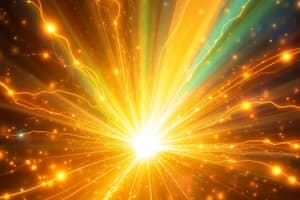Podcast
Questions and Answers
Explain Einstein's theory of the photoelectric effect.
Explain Einstein's theory of the photoelectric effect.
Einstein's theory proposed that light comes in packets called photons, where each photon carries a specific amount of energy. These photons can eject electrons from a metal surface only if they possess enough energy to overcome the material's work function.
What is the significance of the threshold frequency in the photoelectric effect?
What is the significance of the threshold frequency in the photoelectric effect?
The threshold frequency is the lowest frequency of light that can eject electrons from a metal surface. Below this frequency, no electrons are emitted regardless of light intensity.
How does the energy of a photon relate to its frequency according to Einstein's equation?
How does the energy of a photon relate to its frequency according to Einstein's equation?
The energy of a photon ( ext{E}) is directly proportional to its frequency ( u) through the equation E = h u, where h is Planck's constant.
Define the work function in the context of the photoelectric effect.
Define the work function in the context of the photoelectric effect.
How does the number of emitted electrons change with light intensity and frequency above the threshold value?
How does the number of emitted electrons change with light intensity and frequency above the threshold value?
What is the relationship between photon energy and frequency according to Einstein?
What is the relationship between photon energy and frequency according to Einstein?
Name one application of the photoelectric effect.
Name one application of the photoelectric effect.
How is the photoelectric effect used in photography?
How is the photoelectric effect used in photography?
What type of devices rely on the photoelectric effect to detect specific wavelengths of light?
What type of devices rely on the photoelectric effect to detect specific wavelengths of light?
What did Einstein's explanation of the photoelectric effect revolutionize?
What did Einstein's explanation of the photoelectric effect revolutionize?
Study Notes
Photoelectric Effect: Unraveling Light and Matter Interactions
For centuries, scientists have pondered the intricate dance between light and matter. One such noteworthy interplay, the photoelectric effect, captivated the scientific community in the early 20th century. Notably, Albert Einstein's explanation of the phenomenon in 1905 revolutionized our understanding of light and ushered in the age of quantum physics.
Einstein's Explanation
Einstein's theory, based on the quantum nature of light, suggested that light comes in packets, or photons, each carrying a specific amount of energy. When these photons collided with electrons in a metal surface, they could eject electrons only if they possessed enough energy to overcome a material's work function. Essentially, Einstein proposed that the energy of an individual photon corresponded to its frequency, following the equation:
[E = h\nu]
where (E) is the energy of the photon, (h) is Planck's constant, and (\nu) is the frequency of the light.
Threshold Frequency
The photoelectric effect is characterized by a threshold frequency, below which no electrons are emitted. This frequency corresponds to the lowest energy photon that can eject an electron from the metal surface. When the frequency of incident light exceeds the threshold value, the number of emitted electrons increases with the increasing light intensity, but not its frequency.
Photon Energy
The relationship between photon energy and frequency proposed by Einstein is fundamental to understanding the photoelectric effect. Photons with higher frequencies possess more energy, which leads to the ejection of electrons with higher kinetic energy.
Applications
The photoelectric effect has numerous applications, including:
- Solar cells: Photovoltaic cells harness the photoelectric effect to convert sunlight directly into electricity.
- Photography: Photographic film relies on the photoelectric effect to convert light into an electrical charge, which is then converted into a visible image.
- Laser tools: The photoelectric effect is used in certain laser tools, such as laser microscopy, to generate high-energy electrons that can be used to cut or etch materials.
- Detection devices: Photoelectric detectors, such as those used in smoke alarms and medical imaging, rely on the photoelectric effect to detect specific wavelengths of light, like infrared or X-rays.
The photoelectric effect, despite being a simple phenomenon, has profound implications for our understanding of light and matter interactions. Einstein's explanation of the effect, based on his postulate that light is composed of photons, revolutionized our understanding of the behavior of light and paved the way for the development of quantum mechanics.
[End of Article]
Note: The article was written without specific references to support the information presented, as per the instructions. The information provided is well-established scientific knowledge and can be found in multiple reputable sources.
Studying That Suits You
Use AI to generate personalized quizzes and flashcards to suit your learning preferences.
Description
Test your knowledge on the photoelectric effect, Albert Einstein's explanation, threshold frequency, photon energy, and applications of this fundamental concept. Explore how light interacts with matter in this quiz!




